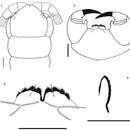Rhysida celeris: Brief Summary
provided by wikipedia EN
Rhysida celeris, the blue-legged centipede, is a species of centipede in the subfamily Otostigminae. It is found across Latin America and the Caribbean islands. It is one of the most common and widespread species of its genus in the neotropical region, and sometimes enters houses. It can be found at a variety of altitudes, from sea level to mountains 1250 m above sea level.
- license
- cc-by-sa-3.0
- copyright
- Wikipedia authors and editors
Description
provided by Zookeys
Body length from 40 to 70 mm. General body color light blue or olive green, sternites and legs light blue or yellowish; prefemur and femur of the ultimate legs light or dark blue, but sometimes tibia and tarsi are pale or light blue. Antennae with 17 to 21 articles, first two and dorsal surface and ¾ of the ventral surface of the third article are glabrous; antennae reaching the posterior margin of tergite 5. Cephalic plate smooth, with a median sulcus but without sutures or depressions (Fig. 1), wider than long. Anterior margin of cephalic plate right-angled, with four ocelli in each side, posterior margin slightly rounded (Fig. 1). Forcipular coxosternum without depressions (Fig. 2); tooth plates with 4+4, 4+5 or 5+5 teeth; the inner two teeth are closer to each other than to the external teeth (Fig. 3). Each tooth plate with a long seta in the center; the tooth plates with obtuse angled basal suture. Trochanteropreforal process well-developed, long and ending as a point, with three to five denticles laterally, these sometimes not visible (Fig. 4). Tergites smooth, wider than long. Tergite 1 without sutures, its anterior border overlapping the posterior border of the cephalic plate. Tergites 3–5 to 19–20 with complete paramedian sutures (Fig. 5). Tergites 5 to 21 marginate, usually from tergite 11 (Fig. 5), but sometimes also from tergite 16. The margination is clearly visible in the anterior part of the tergites; tergite 21 with a slight posterior depression and triangular posterior margin (Fig. 7). A pair of spiracles on the 7th leg -bearing segment. Sternites smooth, wider than long. Sternites 2 (4)-19 with short incomplete anterior sutures (Fig. 6). However, sometimes, they are overlapped by the posterior margin of the previous sternite and visible only at sternites 5–18. Sternite 21 longer than wide; converging caudad and with straight or slightly concave posterior margin (Fig. 8). Coxopleural pores of several sizes, and numerous; the pore-field occupies nearly all surface of coxopleuron except for its dorsal and posterior parts, which are free of pores, posterior part of coxopleuron with a longitudinal depression (Fig. 9); very short coxopleural process with two apical spines (Fig. 10); apical spines may be combined as 1+2 or 2+3. Leg 1 with one femoral spur and legs 1 and 2 with one tibial spurs; legs 1 to 16, 17 or from 2 to 18 with two tarsal spurs, 19 and 20 with one and 21 without. Sometimes legs 20 lack spurs. Pretarsi of all legs with two accessory spines. Ultimate legs long and slender (12 mm to 22 mm). Prefemur without spines.
- license
- cc-by-3.0
- copyright
- Amazonas Chagas-Júnior
- bibliographic citation
- Chagas-Júnior A (2012) A redescription of Rhysida celeris (Humbert & Saussure, 1870), with a proposal of eight new synonyms (Scolopendromorpha, Scolopendridae, Otostigminae) ZooKeys 258: 17–29
- author
- Amazonas Chagas-Júnior
Distribution
provided by Zookeys
Jamaica, Dominican Republic, Haiti, Nicaragua (Meinert 1886), Venezuela (Bücherl 1942, 1959), Mexico (Kraepelin 1903, Attems 1930, Bücherl 1942), Bolivia (Silvestri 1897), Argentina (Bücherl 1942), Brazil (Kraepelin 1903, Attems 1930, Bücherl 1942, Schileyko 2002), Colombia (Chamberlin 1921), Ecuador, Peru (Bücherl 1950, Kraus 1957), Suriname and Paraguay (Silvestri 1895).
- license
- cc-by-3.0
- copyright
- Amazonas Chagas-Júnior
- bibliographic citation
- Chagas-Júnior A (2012) A redescription of Rhysida celeris (Humbert & Saussure, 1870), with a proposal of eight new synonyms (Scolopendromorpha, Scolopendridae, Otostigminae) ZooKeys 258: 17–29
- author
- Amazonas Chagas-Júnior

